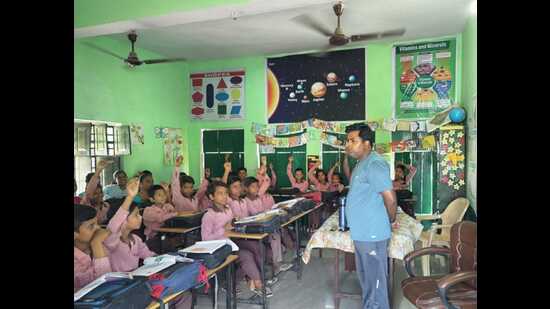Nainital ki sair, Hamara Hindustan: Two new chapters added for Urdu students of government-run schools
یو پی کے سرکاری اسکولوں میں اردو طلباء کو "ہمارا ہندوستان" اور "نینی تال کی سیر" جیسے نئے مضامین پڑھائے جائیں گے۔
Urdu students enrolled in class 3 of government-run primary (classes 1 to 5) and composite (classes 1 to 8) schools functioning under the UP Basic Education Council across the state will also study about the significance of Sangam, the confluence of the Ganga and Yamuna in Prayagraj.

The topic on Sangam has been included in ‘Hamara Hindustan’ which is one of the two chapters included in their Urdu textbook Sitar-1, said officials of the state basic education department. Another chapter is ‘Nainital ki sair’. Adapting NCERT’s Urdu book Sitar-1 in the context of Uttar Pradesh, which is being introduced in the schools from new year 2025-26, experts of the State Institute of Education (SIE)-Prayagraj have added these two chapters to the book.
The move will impact over 20 lakh students enrolled in class 3 in more than 1 lakh schools under the UP Basic Education Council.
It is worth mentioning that NCERT-prescribed books are being adapted as per UP’s needs and with NCERT’s permission before being introduced for different classes of government-run primary and upper primary schools in a phased manner. This process began last year with classes 1 and 2 and has now extended to class 3.
As part of the exercise, in place of the ‘Bhalaaye’ story in NCERT Urdu textbook of class 3, ‘Hamara Hindustan’ based on Indian unity, civilization and culture has been added, said Naval Kishore, principal of the State Institute of Education (SIE)-Prayagraj.
This lesson describes Indian culture as well as the confluence of Ganga and Yamuna located in Prayagraj, a major pilgrimage site of Uttar Pradesh. There is also a mention of Taj Mahal, one of the seven wonders of the world in the chapter.
There is a mention of great Indian personalities like Gautam Buddha, Moinuddin Chishti, Guru Nanak and Mahatma Gandhi. There is also mention of local languages spoken in different states of India and emphasis has been laid on learning the national language Hindi, he added.
Apart from this, the chapter on ‘Kashmir’ has been replaced for UP with a chapter ‘Nainital ki sair’ (A trip to Nainital).
In this chapter too the journey starts from the historical and cultural city of Prayagraj. There is a description of other cities of the state like Lucknow and Bareilly falling on the way of the journey. The names of some famous places of Nainital which are in English have been used as is in Urdu, which would be easy for class 3 children to read/pronounce like Tiffin Top, Snow View, China Peak etc.
Through these chapters, efforts have been made to provide a fillip to the vocabulary of children through words used in daily life like station, bus, trolley, ‘itminaan’, ‘hairat’, ‘jhurjhuri’ etc.
Book to help develop understanding towards environment
The newly developed environment textbook of class 3 students ‘Hamara Adbhut Sansar’ is based on four themes: Our family and community, life around us, gifts of nature and what is around us. Experts say that this will develop understanding in children towards their family, their neighbourhood, gifts given by nature as well as the environment around them. While reading the textbook, children will feel a sense of belonging and attachment towards the environment which is its main feature.





